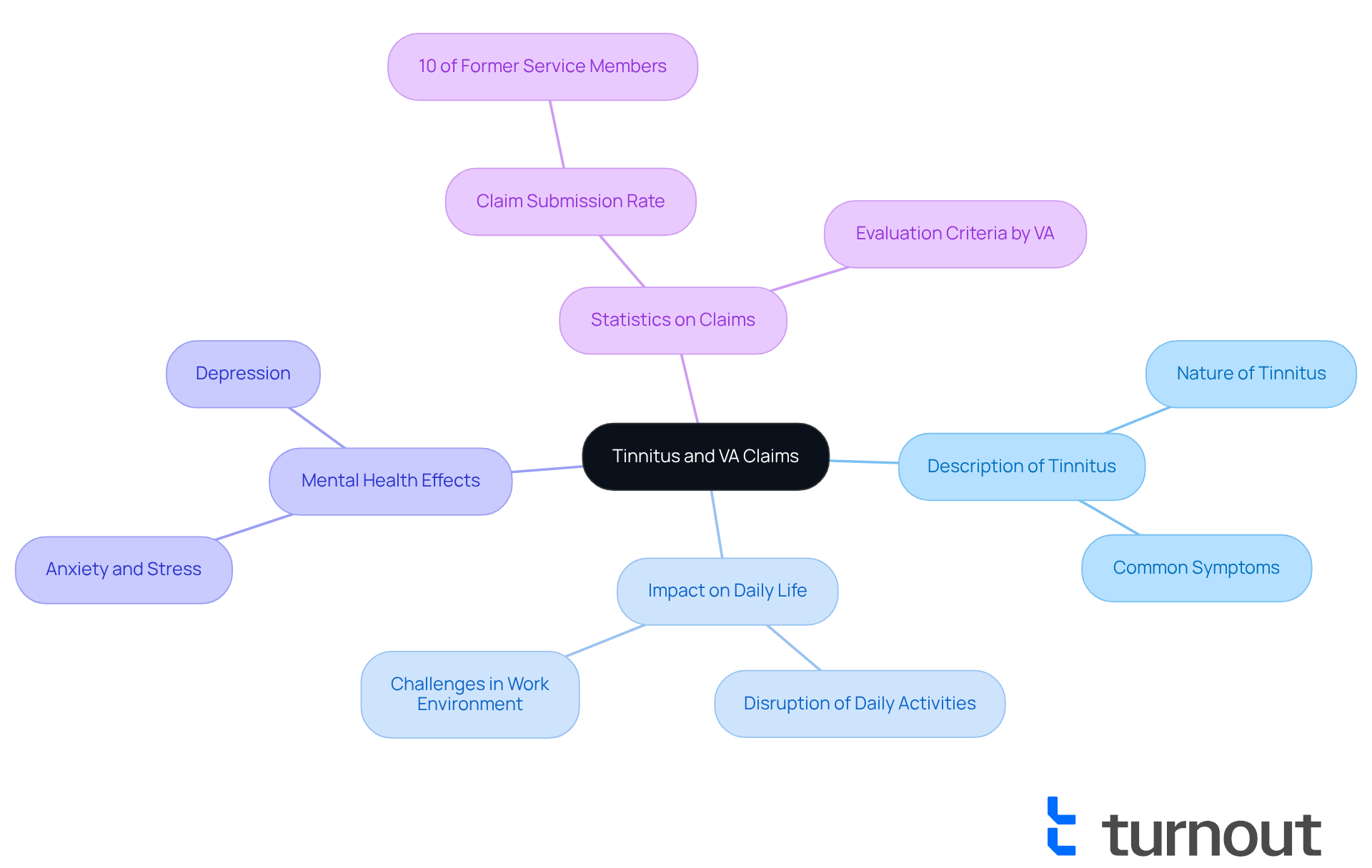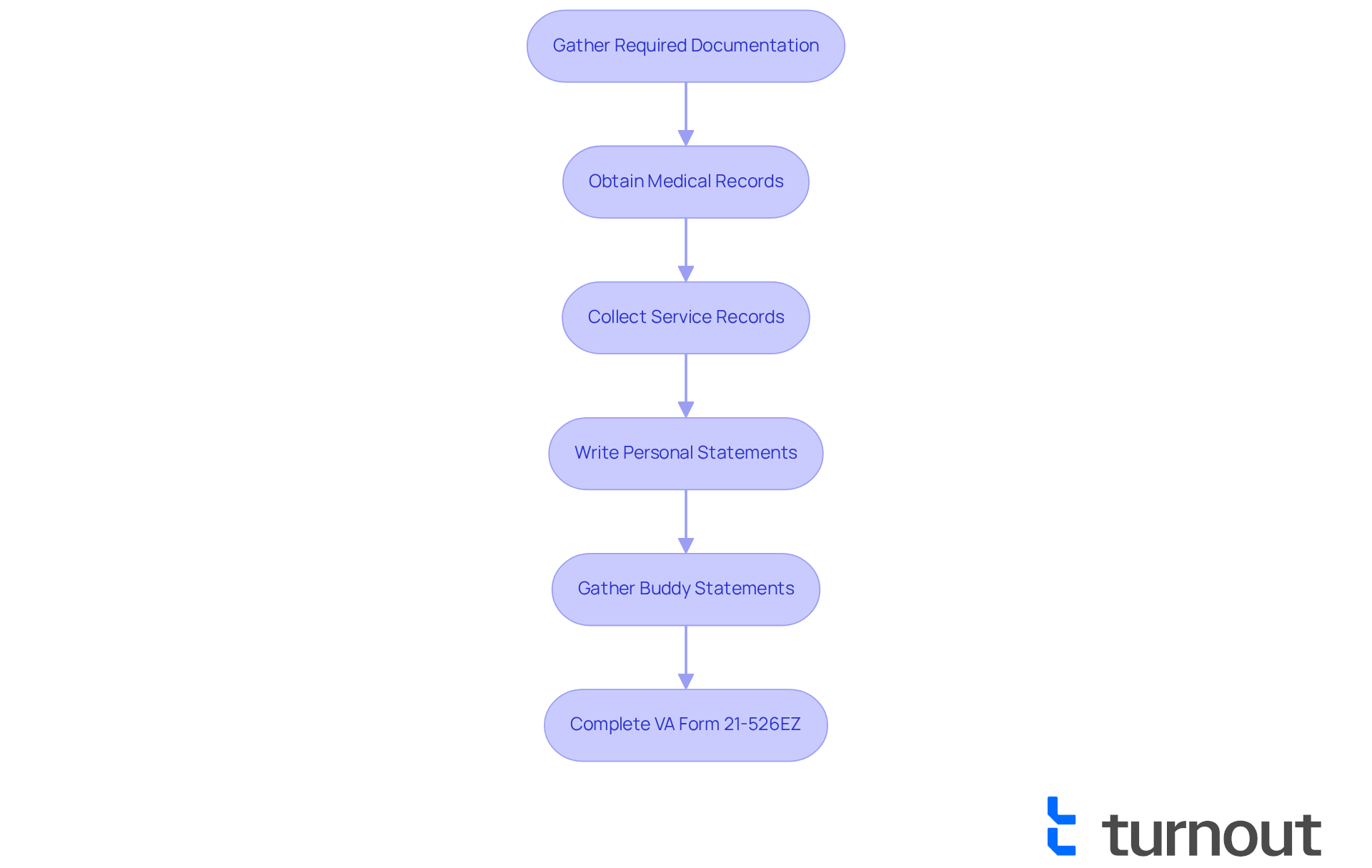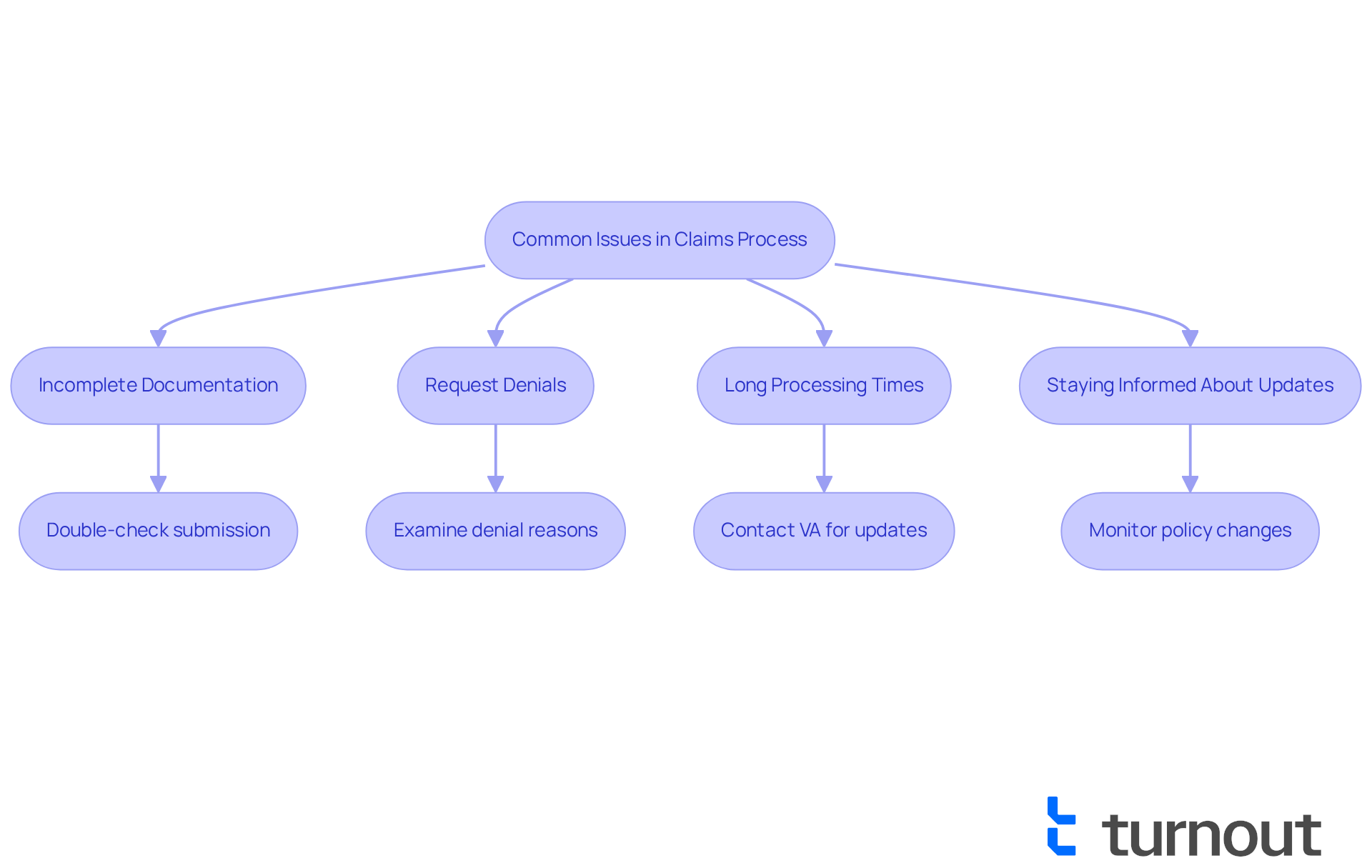Overview
The article "Master Your Tinnitus VA Claim: A Step-by-Step Guide" is dedicated to supporting veterans on their journey to successfully filing a VA claim for tinnitus. We understand that this process can be overwhelming, and our goal is to provide you with a clear and compassionate roadmap.
This guide outlines essential steps, including:
- Gathering your medical and service records
- Accurately completing the necessary forms
- Addressing common issues that may arise during the claims process
Thorough documentation is crucial; it not only supports your claim but also significantly increases your chances of approval.
You are not alone in this journey. We’re here to help you navigate these challenges with confidence and clarity. By following the steps outlined in this article, you can take control of your claim and work towards the support you deserve.
Introduction
Tinnitus, often described as a persistent ringing or buzzing in the ears, is a condition that significantly impacts many veterans. This is especially true for those who have been exposed to loud noises during their service. We understand that the nuances of tinnitus can be overwhelming, particularly when it comes to navigating VA claims. It's crucial for former service members seeking compensation to grasp these complexities.
As veterans embark on the journey of filing a claim, they face challenges that extend beyond just gathering the necessary documentation. Communicating the profound effects of tinnitus on daily life can feel daunting. How can veterans ensure their claims are successful and truly reflect their experiences? You are not alone in this journey. We’re here to help you understand the process and advocate for your needs.
Understand Tinnitus and Its Impact on VA Claims
Tinnitus, often described as a ringing, buzzing, or hissing noise in the ears, is a common condition among our former military personnel, particularly those who faced loud sounds during their service. We understand that recognizing the nature of this ringing in the ears is vital for those submitting a tinnitus VA claim. This condition is classified as a disability within the VA system, and nearly 10% of former service members file a tinnitus VA claim to receive compensation for it.
The impact of tinnitus can vary greatly, affecting daily life, mental health, and overall well-being. It's important to identify these effects so that former service members can clearly convey their experiences in their requests. The VA evaluates submissions based on the seriousness of the condition and its influence on your life.
Remember, you are not alone in this journey, and we’re here to help you navigate through it.

Gather Required Documentation and Establish Eligibility
If you’re a veteran facing hearing-related issues, we understand how challenging it can be to navigate the tinnitus VA claim process. To successfully submit a tinnitus VA claim, it’s essential to gather specific documentation that verifies your eligibility. Here’s how you can build a strong case:
-
Medical Records: Start by obtaining records from your healthcare providers that confirm a diagnosis of tinnitus. This may include audiograms or other hearing tests. A formal diagnosis is crucial for your tinnitus VA claim, as the VA requires clear medical evidence linking your condition to military service.
-
Service Records: Collect documentation that demonstrates your exposure to loud noises during military service. This can include deployment records, unit assignments, and Military Occupational Specialty (MOS) records. Having this evidence is essential for establishing a service connection for a tinnitus VA claim, as many requests are unfortunately rejected due to inadequate proof of noise exposure.
-
Personal Statements: Consider writing a detailed account of how your condition affects your daily life. Share the limitations it imposes on your work or social activities. Personal statements can significantly strengthen your argument by providing context on the impact of your condition.
-
Buddy Statements: Gather statements from fellow service members who can confirm your noise exposure and the early signs of tinnitus. These testimonials can offer crucial support for your claims.
-
VA Form 21-526EZ: Complete this application form for disability compensation, ensuring that every section is filled out accurately. Attention to detail is vital here, as errors can lead to delays or denials.
By gathering these documents, you can build a compelling case for your tinnitus VA claim, demonstrating both the presence of the issue and its connection to your military service. In fiscal year 2020, more than 2.3 million former service members received compensation for ringing in the ears. This highlights the importance of detailed documentation in securing successful tinnitus VA claims.
It’s also important to recognize that ringing in the ears affects nearly 15% of American adults, illustrating the widespread nature of this issue. While the VA assigns a maximum rating of 10% for tinnitus, you may enhance your overall compensation by claiming secondary service-connected conditions, such as hearing loss or sleep apnea.
If your request is denied, remember that you can submit a Notice of Disagreement (NOD) within one year of the VA decision to initiate the appeals process. You are not alone in this journey; we’re here to help you every step of the way.

File Your Tinnitus VA Claim: Step-by-Step Process
Filing a tinnitus VA claim can feel overwhelming, but we're here to help you through each step. Follow these key steps to ensure your request is handled with care and efficiency:
- Prepare Your Documentation: Gather and organize all required documents. This preparation is essential to help you feel confident as you move forward.
- Complete VA Form 21-526EZ: Take your time to fill out the form accurately, providing all necessary information about your condition and service history. Remember, every detail counts.
- Submit Your Request: You can file your request online through the VA's eBenefits portal, by mail, or in person at a VA regional office. If you choose to file online, ensure you have a verified account ready.
- Track Your Request: After submission, it's important to monitor the status of your request through the VA's online system. This way, you can respond promptly to any requests for additional information, which can ease your worries.
- Respond to VA Requests: Be prepared to provide further documentation or clarification if the VA contacts you for more information. It's common to feel anxious during this process, but providing what they need helps keep things moving.
By adhering to these steps meticulously, you can feel assured that your request is being handled efficiently and effectively. Remember, you are not alone in this journey; support is available to guide you every step of the way.

Troubleshoot Common Issues in the Claims Process
Navigating the process of filing a claim for tinnitus can be challenging for veterans, and it's important to acknowledge these common issues:
- Incomplete Documentation: It's crucial to ensure that all required documents are submitted. Missing information can lead to delays in processing. We recommend double-checking your submission before sending it off to avoid any setbacks.
- Request denials: If your tinnitus VA claim is denied, it's essential to examine the reasons provided by the VA. Common reasons include inadequate evidence or difficulty in demonstrating a service connection. Remember, you have the option to appeal the decision by submitting new evidence or clarifying existing documentation.
- Long Processing Times: We understand that claims can take time to process. If you find yourself experiencing delays, don't hesitate to contact the VA for updates. Keeping a record of all communications can be beneficial in monitoring your request.
- Staying informed about updates in VA policies regarding the tinnitus VA claim applications is vital. Be particularly aware of upcoming modifications in 2025 that may influence how applications are assessed.
By being proactive and informed, you can navigate these challenges more effectively. Remember, you are not alone in this journey, and taking these steps can significantly improve your chances of a successful claim.

Conclusion
Mastering the tinnitus VA claim process is crucial for veterans seeking the compensation they deserve for this often debilitating condition. We understand that navigating this process can feel overwhelming. By understanding the nature of tinnitus, its impact on daily life, and the specific requirements for filing a claim, you can significantly enhance your chances of a successful outcome. This guide outlines the essential steps and considerations necessary to navigate the complexities of the VA claims process effectively.
Key points discussed include the importance of gathering comprehensive documentation, such as:
- Medical and service records
- Personal statements
- Properly completing the VA Form 21-526EZ
Each of these elements plays a vital role in establishing eligibility and reinforcing the connection between military service and tinnitus. It's common to face challenges like incomplete submissions, but addressing these issues empowers you to approach your claims with confidence and clarity.
Ultimately, the journey to secure benefits for tinnitus may be challenging, but it is not insurmountable. Staying informed about the evolving landscape of VA policies and being proactive in addressing potential roadblocks can make a significant difference. Remember, you are not alone in this journey. We encourage you to take action, seek support, and advocate for your rights, ensuring that you receive the care and compensation you have earned through your service.
Frequently Asked Questions
What is tinnitus?
Tinnitus is often described as a ringing, buzzing, or hissing noise in the ears.
Why is tinnitus significant for former military personnel?
Tinnitus is common among former military personnel, particularly those who experienced loud sounds during their service, and it is classified as a disability within the VA system.
How many former service members file VA claims for tinnitus?
Nearly 10% of former service members file a tinnitus VA claim to receive compensation for the condition.
How does tinnitus affect daily life and mental health?
The impact of tinnitus can vary greatly, affecting daily life, mental health, and overall well-being.
What should former service members do when submitting a tinnitus VA claim?
It is important for former service members to identify the effects of tinnitus on their lives to clearly convey their experiences in their claims.
How does the VA evaluate tinnitus claims?
The VA evaluates submissions based on the seriousness of the condition and its influence on the individual's life.
Is there support available for those navigating tinnitus claims?
Yes, there is support available to help former service members navigate the process of submitting tinnitus claims.




